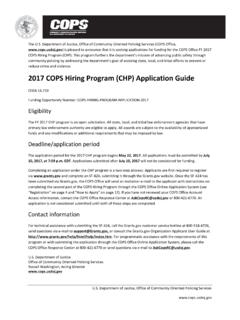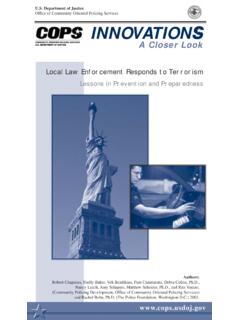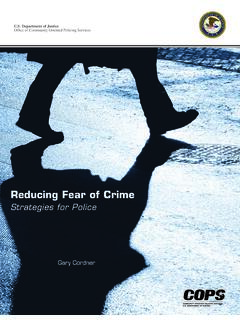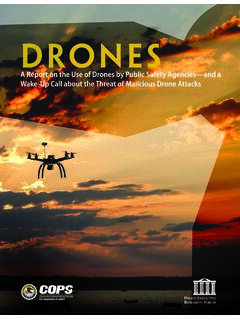Transcription of Introductory Guide to Crime Analysis and Mapping
1 IINNTTRROODDUUCCTTOORRYYGGUUIIDDEETTOOCC RRIIMMEEAANNAALLYYSSIISSAANNDDMMAAPPPPII NNGGI ntroductory Guide to Crime Analysis and Mapping Written by: Rachel Boba, Director, Crime Mapping Laboratory Police Foundation November 2001 Report to the Office of Community Oriented Policing Services Cooperative Agreement #97-CK-WXK-004 The opinions, findings, and conclusions or recommendations expressed in this document are those of the authors and do not necessarily represent the official position or policies of the Department of Justice. Acknowledgements 3 Acknowledgements The author would like to thank Kristin Quayle for transcribing our training session during her summer here at the Police Foundation, as well as Mary Velasco and Erin Lane, Research Associates at the Police Foundation, for their careful review and of Contents 4 PageI.
2 8 II. Introduction to Crime Analysis .. 9 Definition of Crime 9 Types of Crime Analysis .. 11 Intelligence Analysis .. 11 Criminal Investigative Analysis .. 12 Tactical Crime 13 Strategic Crime 13 Administrative Crime Analysis .. 14 Crime Analysis Model .. 15 III. Introduction to Crime Mapping .. 17 Historical Overview .. 17 Types of Mapping .. 18 Manual Pin Mapping .. 18 Computer Mapping .. 19 Geographic Information System (GIS) .. 19 Crime Analysis Mapping .. 20 GIS 20 Data 20 Point 20 Line 21 Polygon 21 Image 22 Data of geographic features.
3 23 Point 23 Line 24 Polygon 24 Table of Contents 5 PageGIS toolbox .. 25 25 26 26 Visual display/ Mapping .. 27 Thematic 27 28 Querying GIS data .. 31 Tabular 31 Spatial 32 IV. Introduction to Problem Solving .. 34 Definition of Problem Solving .. 34 SARA Approach to Problem Solving .. 34 34 Analysis .. 34 35 35 Crime Analysis and Problem Solving .. 36 V. Data and Geocoding .. 37 Types of Data .. 37 Tabular Data .. 37 Geographic Data .. 37 General Data Integrity Issues .. 38 Data Entry .. 38 Timeliness .. 38 Data Validity .. 38 Reliability.
4 39 Data Transfer 39 Data Confidentiality/Privacy .. 39 Table of Contents 6 PageData Management .. 40 Metadata .. 40 Geocoding .. 40 Introduction .. 40 The geocoding process .. 41 Step 1: Prepare the geographic and tabular files for 41 Step 2: Specify geocoding 45 Step 3: 46 Step 4: Review 48 Step 5: If necessary, respecify parametersand geocode again.. 50 Conclusion .. 51 VI. Spatial Analysis 52 Single Symbol Mapping .. 52 Graduated Mapping .. 55 Graduation By Size .. 55 Graduation By 57 Classification Methods .. 59 Natural 59 60 Equal 61 Equal interval.
5 62 Standard deviation .. 63 65 VII. Crime Analysis Product Format and 67 Factors to 67 Methods of Dissemination .. 67 Components of Crime Analysis Products .. 68 Table of Contents 7 PageTypes of Crime Analysis Products .. 68 General Crime Analysis Product Elements .. 70 Map Design 71 Evaluating the Utility of Crime Analysis and Mapping Products .. 73 VIII. References .. 74 Introduction8I. Introduction The following Guide was developed from the curriculum for the Introduction to Crime Analysis Mapping and Problem Solving training course conducted by members of the Police Foundation s Crime Mapping Laboratory in 2001 and funded by the Office of Community Oriented Policing Services (COPS).
6 The purpose of this document is to convert the information presented in the training into a succinct and readable report that makes it available to a larger audience than was reached through the training sessions. It is not intended to be a comprehensive document on Crime Analysis , Crime Mapping , and problem solving, but rather a starter guidebook for someone just entering the field or a reference manual for current Crime analysts or other law enforcement analysts. The format of the document follows the format of the training slides loosely, but it is not necessary to read them together.
7 This document stands on its own. For further reading on Crime Analysis and Mapping , see other relevant documents written by the Police Foundation at or to Crime Analysis 9II. Introduction to Crime Analysis As an introduction to Crime Analysis , this section provides the definition of Crime Analysis as a general concept as well as definitions of five types of Crime Analysis . These definitions are used in the Police Foundation s Introduction to Crime Analysis Mapping and Problem Solving course and have been created to synthesize current concepts and ideas in the field of Crime Analysis .
8 These definitions are meant to enhance the understanding of Crime Analysis and to help create commonly understood terminology. The latter part of this section includes a hierarchical model by which all five types of Crime Analysis are related to one another. Definition of Crime Analysis The qualitative and quantitative study of Crime and law enforcement information in combination with socio-demographic and spatial factors to apprehend criminals, prevent Crime , reduce disorder, and evaluate organizational and quantitative. Crime Analysis uses both qualitative and quantitative data and analytical techniques.
9 Qualitative data and analytical techniques refer to non-numerical data as well as the examination and interpretation of observations for the purpose of discovering underlying meanings and patterns of relationships. This is most typical of field research, content Analysis , and historical research. Quantitative data are data primarily in numerical or categorical format. Quantitative Analysis consists of manipulations of observations for the purpose of describing and explaining the phenomena that those observations reflect and is primarily statistical. Crime Analysis employs both types of data and techniques depending on the analytical and practical need.
10 For example, Crime data can be used in various ways, both quantitatively and qualitatively. The information such as date, time, location, and type of Crime is quantitative in that statistics can be used to analyze these variables. On the other hand, narratives of Crime reports are considered qualitative data in that a large number of narratives are nearly impossible to analyze statistically and are primarily examined to determine general themes and patterns. Study. Study is a systematic way of looking at Crime and law enforcement information. That is, Crime Analysis is not examining information haphazardly but rather is applying formal analytical and statistical techniques as well as research methodology to law enforcement information according to the rules of social science.














